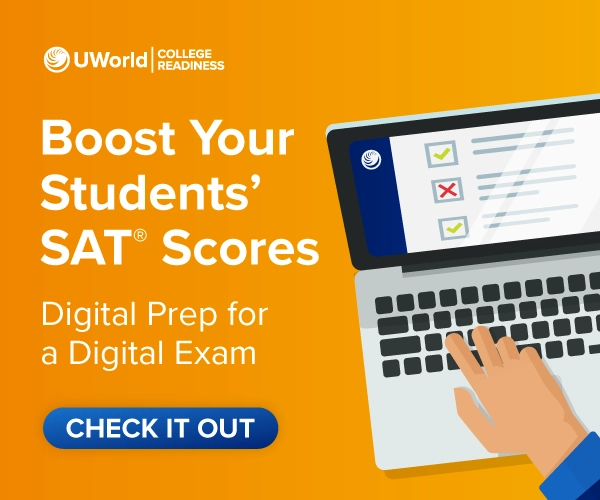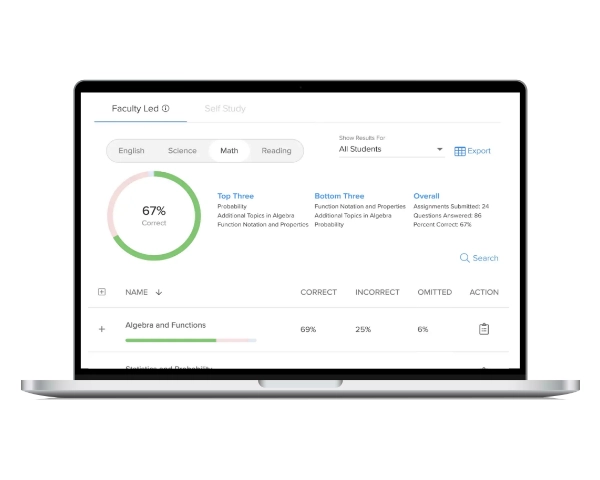For many students, the Preliminary SAT/National Merit Scholarship Qualifying Test (PSAT/NMSQT) feels like a low-stakes warm-up. For educators, it's a valuable guide that reveals where students are now. Use it to support them on a path toward success on the SAT Exam, which can often feel insurmountable.
The PSAT/NMSQT score report is a powerful diagnostic tool. More than a practice test, it offers a clear, actionable SAT study plan for student growth so you can guide them to study smarter, not harder.
PSAT Score Report: Your Instructional Compass
The PSAT score report measures the same core knowledge and skills as the SAT. It's a strong, reliable predictor of students' potential Digital SAT Exam performance. It is a consistent benchmark, allowing you to see where students are now and where they need to grow.
PSAT Sections to Focus On (Your Guiding Stars):
When you break down the report's key sections, you gain clear direction on where students excel, where they struggle, and how to target instruction for meaningful improvement.
Subscores
Subscores are critical data points for instructional purposes. The PSAT breaks down student performance into specific skill areas within reading, writing, language, and math. Low subscores immediately flag specific concepts or skills that need focused classroom review or individualized tutoring.
Knowledge and Skills Section
This visual breakdown shows how students perform across 8 skill domains, with examples of what they must master to reach the next score band. Using these examples in class can make improvement goals tangible, connecting daily instruction to test-day performance.
Grade-Level Benchmarks
Benchmarks indicate whether students are on track for college readiness in all tested subjects. Identifying students who fall below these benchmarks early on allows you to intervene promptly and provide targeted support.
3-Phase SAT Study Plan to Turn PSAT Data into Action
Once you've identified student needs through the PSAT, you can transform those insights into a focused, efficient SAT Exam preparation strategy.
This 3-phase approach takes students from targeted skill building to full test-day readiness, helping them strengthen weaknesses, build stamina, and refine their SAT Exam study strategy without overwhelming them.
Phase 1: Targeted Skill Building
This initial phase is all about precision. It's the foundation of an actionable SAT study plan, helping students focus their efforts where they'll truly yield the greatest return.
Direct Link
|
Emphasize Explanation ReviewInstruct students to review every detailed explanation, right and wrong answers, to understand why an answer is correct. |
Promote Quality over QuantityEncourage a smaller set of questions reviewed thoroughly over large, rushed sets. Have students keep an error log or notebook for challenging concepts and new strategies learned. |
Phase 2: Section Mastery and Pacing
Once foundational skills are in place, focus on building full-section proficiency and developing time management.
Broaden
|
Integrate Time ManagementIncorporate timed practice sessions to mirror SAT pacing and help students develop a test-day rhythm. |
Facilitate Consistent ReviewSchedule regular review of flagged or incorrect questions to reinforce learning and prevent repeated errors. |
Phase 3: Full-Length Simulation and Refinement
Prepare students for the real test experience and focus on final adjustments.
Administer Full-Length Practice TestsHave students take at least 2 to 3 practice tests under strict, timed conditions to build stamina and familiarity. |
Guide Post-Test AnalysisDedicate time to reviewing every question to identify recurring error patterns and inform targeted follow-up practice. |
Iterative
|
Best Practices for Educators to Build Student Growth
Encouraging students to interpret their own PSAT results as opposed to relying on class time alone builds ownership, focus, and accountability. Pair a supportive classroom environment with individual engagement by following these best practices:
- Encourage Consistency: Advocate for students to engage in regular, scheduled study sessions with manageable time blocks instead of last-minute cramming. Emphasizing steady, focused effort helps students retain skills and build confidence.
- Leverage Reporting Tools: Use UWorld's performance tracking to monitor progress, identify trends, and provide targeted feedback. Reviewing this data with students reinforces accountability and shows them the tangible results of their efforts over time, creating momentum.
- Promote Student Well-Being: Remind students of the importance of rest, hydration, and balanced study to avoid burnout. A well-rested, healthy student is more likely to stay engaged and perform at their best.
- Foster a Growth-Minded Culture: Emphasize growth and improvement over chasing a single score. Letting students know their efforts are seen and valued, and that support is readily available for their journey, can build immense confidence.
- Reduce Pressure to Unlock Performance: Remind students that while the SAT is important, it's not the sole measure of their potential. Students often perform better when the stakes feel lower because they are more relaxed and less focused on chasing scores.
The PSAT/NMSQT is so much more than a preliminary assessment. It's a powerful diagnostic tool that can truly revolutionize SAT preparation.
By meticulously analyzing PSAT data and guiding students through targeted, high-quality practice, educators can empower them to transform their weaknesses into strengths, build individual confidence, and ultimately achieve their best SAT scores.
Frequently Asked Questions (FAQs)
What is a good PSAT score to predict SAT success?
Meeting or exceeding college and career readiness benchmarks from College Board® indicates a student is on track for college-level work. While there’s no single “magic” good PSAT number, scores in the higher percentiles typically translate into competitive SAT performance.
How much can a student improve from PSAT to SAT?
Improvement varies widely and depends on factors such as preparation time, focus, and how effectively students use their PSAT results to guide practice. Students who use their PSAT results to pinpoint weaknesses, practice consistently, and focus on targeted skill-building are more likely to see meaningful growth.
Can PSAT scores be used to identify test-taking strategies?
Yes. PSAT results can reveal what content a student needs to review and where test-taking strategies can be applied, such as pacing, question prioritization, and eliminating wrong answers efficiently.
What are common mistakes when interpreting PSAT scores?
One mistake while interpreting PSAT Scores is focusing solely on the total score instead of subscores and skill domains, which offer the most actionable insights. Another is assuming a high PSAT score guarantees the same SAT result without continued preparation.
How can educators support students with testing anxiety?
Support starts with creating a positive, low-pressure environment around test preparation. Encourage regular practice under test-like conditions, teach stress-reduction techniques, and remind students that improvement is a process.
References
- College Board. (n.d.). PSAT/NMSQT understanding scores [PDF]. SAT Suite of Assessments. https://satsuite.collegeboard.org/media/pdf/psat-nmsqt-understanding-scores.pdf
- College Board. (n.d.). What SAT, PSAT/NMSQT, and PSAT 10 scores mean. SAT Suite of Assessments. https://satsuite.collegeboard.org/scores/what-scores-mean










